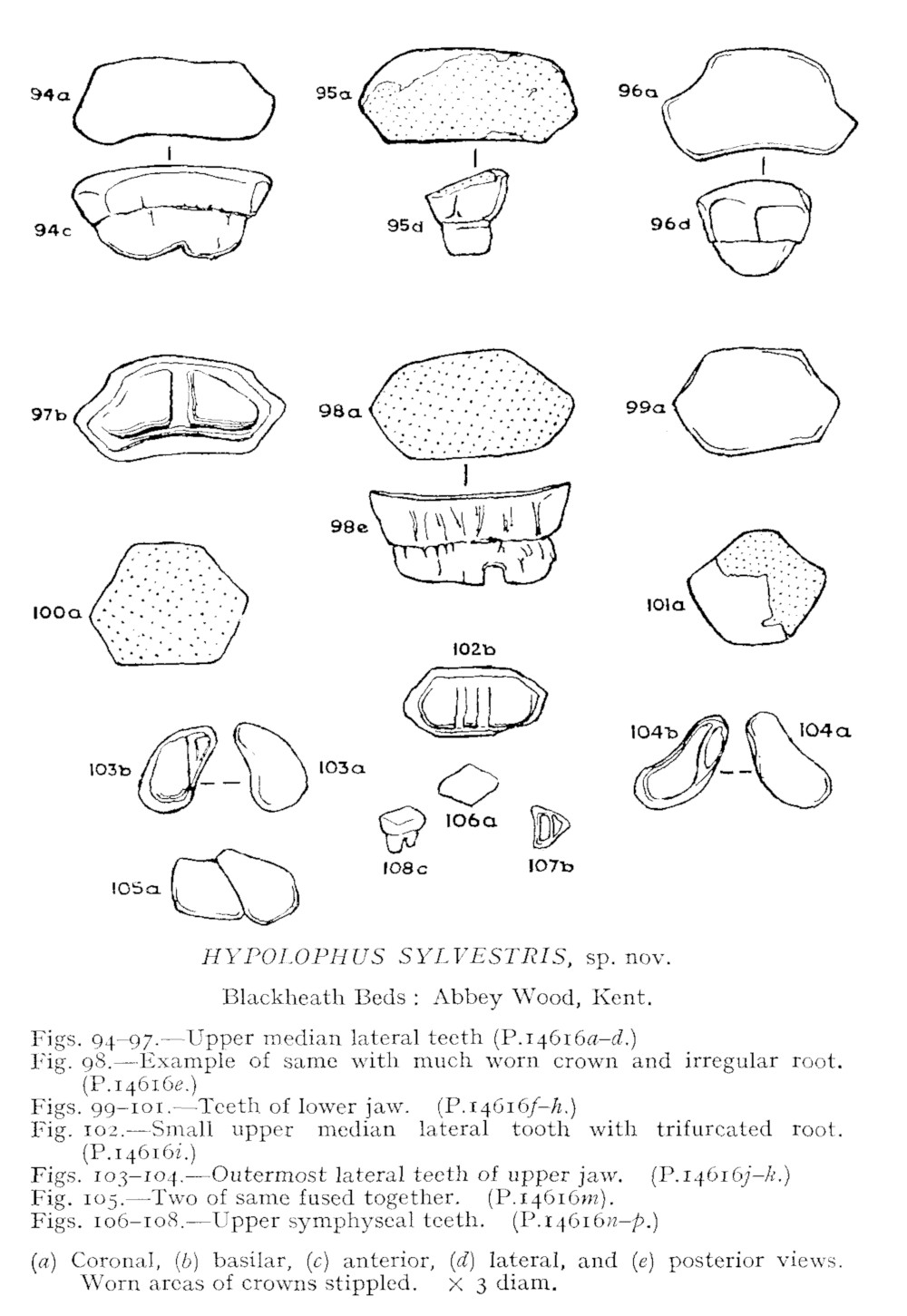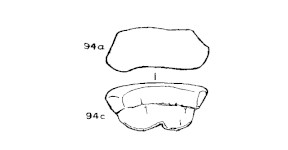Hypolophus sylvestris
White, 1931
Classification: Elasmobranchii Myliobatiformes Dasyatidae
Reference of the original description
The vertebrate faunas of the English Eocene. I. From the Thanet Sands to the Basement Bed of the London Clay. British Museum (Natural History): 121 p., 162 fig.
The vertebrate faunas of the English Eocene. I. From the Thanet Sands to the Basement Bed of the London Clay. British Museum (Natural History): 121 p., 162 fig.
Image of the original description

<i>Hypolophus sylvestris</i> White, 1931 Fig. 94-108 in White, 1931

<i>Hypolophus sylvestris</i> White, 1931 Fig. 94-108 in White, 1931
Description:
Citation: Hypolophus sylvestris White, 1931: In: Database of fossil elasmobranch teeth www.shark-references.com, World Wide Web electronic publication, Version 12/2025
Description
Original diagnosis after White (1931) p. 70 [2532]: A species of Hypolophus known only by isolated teeth (and dermal tubercles). Teeth similar in form, arrangement and size to those of the living H. sephen (Forskal), but sides of crown always sloping inwards and overhanging the root, and median lateral teeth of upper jaw relatively wider. (Dermal tubercles variable in size and shape; larger forms longer than wide, with upper surface ornamented with numerous grooves radiating from a small, much elevated central spine sloping backwards, and large root convex and smooth; smaller tubercles similar but rounded, with vertical median spine.)
Original diagnosis after White (1931) p. 70 [2532]: A species of Hypolophus known only by isolated teeth (and dermal tubercles). Teeth similar in form, arrangement and size to those of the living H. sephen (Forskal), but sides of crown always sloping inwards and overhanging the root, and median lateral teeth of upper jaw relatively wider. (Dermal tubercles variable in size and shape; larger forms longer than wide, with upper surface ornamented with numerous grooves radiating from a small, much elevated central spine sloping backwards, and large root convex and smooth; smaller tubercles similar but rounded, with vertical median spine.)
Remarks
shark-references Species-ID=3121;
type species of Hypolophodon Cappetta, 1980 p. 39 [328] by original designation (Art. 68.2 ICZN);
valid after White (1931) p. 70 [2532];
synonym of Hypolophodon sylvestris after Cvancara & Hoganson (1993) p. 11 [596]; Case (1996) p. 10 [397]; Cappetta (1980) p. 39 [328]; Ebersole et al. (2019) p. 118 [27789];
shark-references Species-ID=3121;
type species of Hypolophodon Cappetta, 1980 p. 39 [328] by original designation (Art. 68.2 ICZN);
valid after White (1931) p. 70 [2532];
synonym of Hypolophodon sylvestris after Cvancara & Hoganson (1993) p. 11 [596]; Case (1996) p. 10 [397]; Cappetta (1980) p. 39 [328]; Ebersole et al. (2019) p. 118 [27789];
References

The distribution of sharks, rays and chimaeroids in the English Palaeogene. Tertiary Research, 3(1), 13–19

Eine Lagerstätte kreidezeitlicher und paläogener Chondrichthyes-Reste bei Fürstenau (Niedersachsen). Osnabrücker Naturwissenschaftliche Mitteilungen, 6, 35–44

Les Sélaciens des terrains néocrétacés et paléocènes de Belgique et des contrées limitrophes. Eléments d'une biostratigraphie intercontinentale. Mémoires pour servir à l'explication des Cartes géologiques et minières de la Belgique, 15, 1–401

Le Landénien de Dormaal (Brabant) et sa faune ichthyologique. Mémoires de l'Institut Royal des Sciences Naturelles de Belgique, 156, 1–66
Hypolophid teeth from the Woodbine Formation, Tarrant County, Texas. Eclogae Geologicae Helvetiae, 57(2), 538–539

Constitution et évolution de la racine dentaire des Euselachii. II. Étude comparative des types. Bulletin du Musée Royal d'Histoire Naturelle de Belgique, 23(14), 1–32

The vertebrate faunas of the English Eocene. I. From the Thanet Sands to the Basement Bed of the London Clay. British Museum (Natural History): 121 p., 162 fig.

The distribution of sharks, rays and chimaeroids in the English Palaeogene. Tertiary Research, 3(1), 13–19

Eine Lagerstätte kreidezeitlicher und paläogener Chondrichthyes-Reste bei Fürstenau (Niedersachsen). Osnabrücker Naturwissenschaftliche Mitteilungen, 6, 35–44

Les Sélaciens des terrains néocrétacés et paléocènes de Belgique et des contrées limitrophes. Eléments d'une biostratigraphie intercontinentale. Mémoires pour servir à l'explication des Cartes géologiques et minières de la Belgique, 15, 1–401

Le Landénien de Dormaal (Brabant) et sa faune ichthyologique. Mémoires de l'Institut Royal des Sciences Naturelles de Belgique, 156, 1–66
Hypolophid teeth from the Woodbine Formation, Tarrant County, Texas. Eclogae Geologicae Helvetiae, 57(2), 538–539

Constitution et évolution de la racine dentaire des Euselachii. II. Étude comparative des types. Bulletin du Musée Royal d'Histoire Naturelle de Belgique, 23(14), 1–32

The vertebrate faunas of the English Eocene. I. From the Thanet Sands to the Basement Bed of the London Clay. British Museum (Natural History): 121 p., 162 fig.


















